_600.webp) |
| Julian Rosefeldt’s Manifesto star Cate Blanchett is on Broadway in The Present, directed by John Crowley Photo: Anne-Katrin Titze |
In 2014, Cate Blanchett starred with Isabelle Huppert in Andrew Upton's adaptation of Jean Genet's The Maids (Les Bonnes) at Lincoln Center. Now in New York, Blanchett appears live on stage at the Barrymore Theatre, opposite Richard Roxburgh in The Present, Upton's adaptation of Anton Chekhov's Platonov, and on screens in Julian Rosefeldt’s enthralling Manifesto at the Park Avenue Armory.
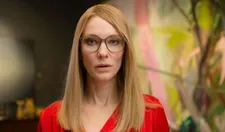 |
| Cate Blanchett as CEO in Manifesto combines the ideas of Wassily Kandinsky, Franz Marc, Wyndham Lewis and Barnett Newman |
The words of Yvonne Rainer, Mierle Laderman Ukeles, Olga Rozanova, Adrian Piper and Elaine Sturtevant flow alongside those of Lars von Trier, Stan Brakhage, Werner Herzog, Jim Jarmusch, Thomas Vinterberg, Tristan Tzara, Paul Éluard, Claes Oldenburg, Sol LeWitt, Barnett Newman, Kurt Schwitters, Francis Picabia, André Breton, Antonio Sant'Elia, Lebbeus Woods and others in Rosefeldt's installation.
13 individual scenes on 13 monitors present a wide array of manifestos, clustered together by movements with the chameleonic Cate Blanchett giving them all new context in contemporary situations. The result can be exhilarating. Historic meaning flies out of the window and yet, it is possible to catch their insight by letting go. This is where blasphemy comes in. Which of the predominantly heated young men would be smiling or laughing with the work?
Historically, manifestos are declarations very much tied to a time and place and a mission from an author meant to provoke change. The experience of walking through Rosefeldt's installation rids the proclamations from their context and transports them into the present, that is, into the Drill Hall of the Armory, built between 1877 and 1881. The 19th Century and the 21st take some control over the 20th. Tales from the oral tradition were of unknown origin and the internet is heavy with untraceable flotsam. Yet if you think that in Manifesto-land there are no authors and only one uniting female voice, you might wander astray.
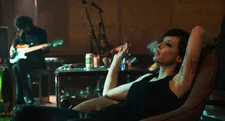 |
| Cate Blanchett as the tattooed punk: "Logic is a mistake and the right to wholeness a monstrous joke." |
There is a moment in each short film where Blanchett turns directly to the camera and in monotone speaks lines of truth and dare to us. As they all happen at the same time, her voice becomes a chorus, the Park Avenue Armory shivers and meaning trembles in suspension.
- At the entrance, as a famous foreword of things to come or not to come, visitors are greeted by a burning fuse and Cate Blanchett's voice speaking excerpts from Karl Marx and Friedrich Engels' 1848 Manifesto Of The Communist Party, mixed with some Tristan Tzara and Philippe Soupault.
- Screen two, if you proceed clockwise through the exhibit, is dedicated to Situationism. Three old women light firecrackers on a wintry lawn in the midst of an abandoned industrial site. Are they more like the three kids from Michelangelo Antonioni's La Notte or is this hinting at a Macbeth prophecy? A homeless man (Blanchett) shuffles by them with his dog, quoting Guy Debord and Constant Nieuwenhuys. There is a shelter on top of the world.
- Stridentism and Creationism show Blanchett as "Tattooed punk", backstage somewhere surrounded by instruments, beer cans, and people who don't listen to her. "Logic is a mistake and the right to wholeness a monstrous joke."
- In the piece about Fluxus/Merz/Performance, Blanchett is a Russian choreographer instructing the dancers who resemble shiny aliens to say "No to the heroic" and "No to the anti-heroic," and not to forget that "Fluxus is inside you." Yvonne Rainer's No and Mierle Laderman Ukeles's Maintenance Art Manifestos combine with Kurt Schwitters' hopes for a Gesamtkunstwerk as told by Gloria Swanson in Sunset Boulevard, or Cinderella's stepmother.
- Combining a funeral with Dadaism is a juxtaposition made in heaven. Blanchett with red short hair and a veil addresses the mourners and three dogs in the words of Tristan Tzara, Paul Éluard or Louis Aragon. "One dies a hero or an idiot - which is the same." The people gathered at the cemetery do not react. "You are all idiots," she tells them and the ritual continues and earth is shoveled onto the open grave.
- As a broker she references the Manifesto of Futurist Painters from 1910. "We will destroy the cult of the past, the obsession with the ancients and academic formalism." Marinetti, Appollinaire and Vertov are also what we hear, screens and desks and a cathedral of business is what we see.
- Claes Oldenburg's Pop Art manifesto, I am for an Art …, is the only text spoken in the seventh film which invites us to a family lunch in the American South. Mother, father and three sons, played by Blanchett's real-life family, sit down to pray before their meal, black and white spaniel at their feet. The dog is not the only animal here. Rosefeldt shows the roasted duck with a gaping hole in close-up. Salt and pepper come in little pig dispensers and the room next to the dining room would put Norman Bates to shame. A black bear, a deer, a beaver and a large raven hold court while the mother recites statements such as "I am for an art of dog turds," to the great amusement of her sons, holding back giggles. It is the juxtaposition of a ritual with words of inflammatory intent that creates the strongest effect.
- A scientist in a hazmat suit walks down a rabbit hole in the shape of a pink and kiwi-colored snail. "There should be a miracle in the creation of art," we hear in this installment about Suprematism/Constructivism. Olga Rozanova conjures up "the outlines of a bull or a deer on a piece of stone."
- Minimalism and Conceptual Art, pioneered by Sol LeWitt, features Blanchett in two roles. A newsreader with Christina Hendrick's hair and a blond reporter in the rain, both call each other Cate, and the manufactured weather report tells us a lot about faking, authenticity in art, footwear, wind-machines and how they go together with a smile. The two Cates debate what it means to be an artist in the words of Elaine Sturtevant and Adrian Piper.
- Architecture manifestos, in a counter-intuitive stroke of genius, are represented here by a worker in a garbage incineration plant on her way to work on a motorbike. If "our houses must be like gigantic machines," is this the result? In one of the most visceral scenes of the installation, you can almost smell the dust and for a moment the Berlin garbage facility might transport you back in time. It is exactly because the manifestos combined with these visuals become bigger than any fixed meaning, that such associations are possible, rather than forced upon us. "I prefer richness of meaning, rather than clarity" is quite a sentence in the context of garbage disposal.
- André Breton's Surrealism and Lucio Fontana's manifesto on Spatialism pull verbal strings for Blanchett as puppeteer and look-alike puppet. There is a lot to see in this workshop. A monkey, Mother Teresa, an astronaut, Freud, Marx, Stalin, a bear, Hitler, Mussolini, and a rabbit are competing with the words. A book on Japanese cinema is seen in the background.
- "A great era has begun," we hear in the next to last film that combines the ideas of Vorticism, Blue Rider, and Abstract Expressionism. Wassily Kandinsky and Franz Marc in 1912, Wyndham Lewis in 1914 and Barnett Newman in 1948 spoke of the sublime or a new era of spirituality on the horizon. Chillingly - laughter at the absurdity will be stuck in your throat - this episode takes place at a CEO's private party in her house by a lake. Party guests stand around on the wintry terrace to smoke and check their phones and drink champagne. "The sublime is now." This party is what is left of the sublime. Caspar David Friedrich's loner now looks down on his phone and not into the distance.
- But wait, there is hope and the future. There are children who will come up with their own manifestos, perhaps. The last installment which also functions as epilogue takes place in a classroom. Blanchett is a teacher who inspects the kids' drawings, giving them advice from filmmakers such as Stan Brakhage or Werner Herzog. Jim Jarmusch's suggestion that "originality is nonexistent" and to "steal from anywhere", is followed beautifully by Lars von Trier and Thomas Vinterberg's Dogma 95 obstructions for filmmakers. "I want you to remember what Jean-Luc Godard said" the teacher tells her little students and then scolds them that "the camera must be hand-held," and "the director must not be credited." With the children running outside into the schoolyard, birds flying up, less Hitchcock than real, Lebbeus Woods gets the last line. "Tomorrow, we begin together the construction of a city."
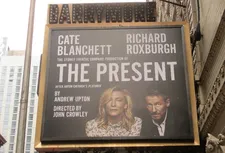 |
| Cate Blanchett and Richard Roxburgh star in The Present at the Barrymore Theatre Photo: Anne-Katrin Titze |
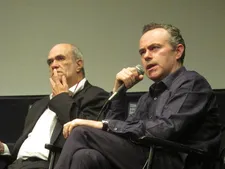 |
| The Present and Brooklyn director John Crowley with novelist Colm Tóibín Photo: Anne-Katrin Titze |
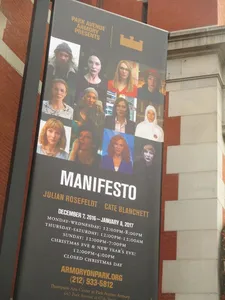 |
| Julian Rosefeldt’s Manifesto at the Park Avenue Armory Photo: Anne-Katrin Titze |
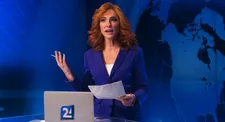 |
| Cate Blanchett as the newsreader debates with Cate as the reporter |
In her 1991 Cyborg Manifesto, Donna Haraway starts out with blasphemy and irony. "Blasphemy has always seemed to require taking things very seriously … Blasphemy protects one from the moral majority within, while still insisting on the need for community … Irony is about contradictions that do not resolve into larger wholes even dialectically, about the tension of holding incompatible things together because both or all are necessary and true." Haraway's manifesto is not part of Julian Rosefeldt's installation which is compiled largely of statements by young fervent males of the 20th Century. And yet, Blanchett's voices and interpretations forcefully conjure up what Haraway calls "an imagination of a feminist speaking in tongues to strike fear into the circuits of the supersavers of the new right."
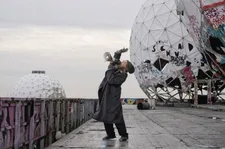 |
| Cate Blanchett as a homeless man: "a new era is upon us." |
Manifesto at the Park Avenue Armory is on view until January 8, 2017.
The Present is currently in previews and will open at the Barrymore Theatre on January 8 running through March 19.
The world premiere of Manifesto, the film, will be at the Sundance Film Festival next month on January 23, 24, 25 and the 28 with director Julian Rosefeldt presenting the first three screenings.





















